|
 Taking place in the fellowship center, the area was filled with
tables of coins, paper money, and unique collectibles. Those who
were participating included several members of the local club plus
collectors from the Springfield and Bloomington clubs. Taking place in the fellowship center, the area was filled with
tables of coins, paper money, and unique collectibles. Those who
were participating included several members of the local club plus
collectors from the Springfield and Bloomington clubs.
Around the room, most of the participants said they collected as a
hobby, but there were a couple of interesting businesses there as
well.
Mike and Joey Johnson are second generation coin dealers from
Rochester. The business was started by their dads who are twins, Pat
and Mike Johnson. The family owned, Dollars & Cents Coin Shop, deals
in a variety of coins and they also do coin grading.
 Mike
said he’d been doing grading for about three years, and Joey started
about a year ago. He said grading coins is an important part of
valuing a coin, and making a mistake can be very costly; so one
learns quickly how to do it right. Mike
said he’d been doing grading for about three years, and Joey started
about a year ago. He said grading coins is an important part of
valuing a coin, and making a mistake can be very costly; so one
learns quickly how to do it right.
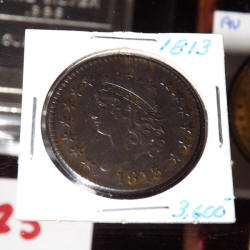 One
of the most expensive coins brought to the show by the Johnson's, an
1813 liberty head, large cent, priced at $3,600. Mike said its value
came from the fact that it is a very rare coin on today’s market.
The unique thing about this old coin is its size. Few may know that
the original one-cent pieces were as large as, or larger, than
today’s silver dollars. One
of the most expensive coins brought to the show by the Johnson's, an
1813 liberty head, large cent, priced at $3,600. Mike said its value
came from the fact that it is a very rare coin on today’s market.
The unique thing about this old coin is its size. Few may know that
the original one-cent pieces were as large as, or larger, than
today’s silver dollars.
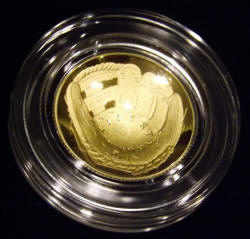 Another
interesting item the coin shop had on hand was the concave baseball
glove issued to commemorate the Baseball Hall of Fame. The special
made gold piece was purchased by order. According to the
Railsplitter Coin Club newsletter, the demand for the piece is
exceeding the mints' ability to supply, so many are still on
backorder. With a limited edition coin or commemorative, the value
can go up based on its lack of availability. On this particular
piece, which is cast in gold, the value will also fluctuate with the
price of gold. Mike pointed out this particular piece has a very
small amount of gold. For the gold alone, he said the piece is only
worth about $400. Another
interesting item the coin shop had on hand was the concave baseball
glove issued to commemorate the Baseball Hall of Fame. The special
made gold piece was purchased by order. According to the
Railsplitter Coin Club newsletter, the demand for the piece is
exceeding the mints' ability to supply, so many are still on
backorder. With a limited edition coin or commemorative, the value
can go up based on its lack of availability. On this particular
piece, which is cast in gold, the value will also fluctuate with the
price of gold. Mike pointed out this particular piece has a very
small amount of gold. For the gold alone, he said the piece is only
worth about $400.

Another interesting business at the show was Steve’s Coin Rings of
Pawnee. When collectors sell coins, they often put several together
in “lots." In the lot, there may be 2, 3 or 4 great coins that have
value, but there will be that many or more that are more-or-less
junk coins. Dealers do this intentionally, pairing good coins with
bad ones knowing that buyers will pay based on the good coins, and
the seller will be able to get rid of some of his junk.

Steve Kern has come up with a way to create
something out of nothing, by turning his junk coins into rings. He
explained that the rings are made by working and shaping the coins
while preserving the images on them. He said he doesn’t apply any
heat to the coin to form it, so when he’s finished, one can still
see what coin the ring used to be. He pointed out the details of one
ring, showing that the outside of the ring was the face of the coin
while, on the inside of the back, one could still see what would
have been the back side.

Around the room, many of the others showing coins
said they did it just as a hobby because they like coins. Included
among those was Logan County resident Bill Haak, former fire chief
with the city of Lincoln. Haak was busy talking with visitors at his
booth, but did take time to point out his 2011 Olympics
commemorative.
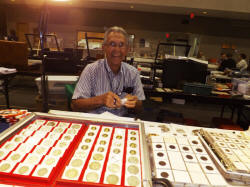
Carl Borngasser and his wife run Carl’s Coins in
Fairbury. Borngasser said having a lucky coin in your pocket isn’t
always a good idea. Looking at an 1881 cent, he pointed out that
over time the ‘lucky’ coin has been worn down, and is now decreased
in value. If one wants a coin to carry in their pocket, there is
nothing wrong with that, but as a collector, that would never be
done.
Mark and Kirk (no last name given) are hobbyists. They
collect coins as well as paper. Mark offered up a piece of
advice to would-be collectors -- "never, ever, clean a coin."

Kirk is interested in paper money and was happy to show off and
explain a silver certificate. Back when paper money was coming into
play, many people didn’t want it. They preferred the jingle-jangle
of coins in their pockets. So the first bills printed were not
dollars; they were silver certificates. When someone was given a
silver certificates, it meant they could take it to the bank and
exchange it for silver coins. Of course, they could also use the
notes to make purchases. Eventually, the practice of exchanging
paper for merchandise caught on and the silver notes evolved into
dollar bills.
[to top of second column] |

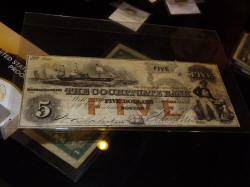
In addition, “way back when,” banks issued their own currency. Local
banks printed bank notes that were dollar equivalent. He pointed out
one such bank note he has in his collection that is from a bank in
Boston. He said one of the neat things about the bank note is the
artistry involved. Each bank designed their own notes, and they were
works of art in their own right.
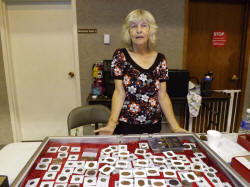
Another collector from Springfield was Sue Wilson. Wilson enjoys
collecting pressed coins. Pressed coins are souvenirs that can be
purchased at many tourist attractions around the country. Typically
the buyer will insert a quarter into a hand operated press. He or
she can then crank out their own souvenir penny, which will come out
paper thin with an image of the tourist attraction.

Richard Pearce, who is the president of the Railsplitter Club,
collects foreign coins. Foreign coins he said are not made out of
precious metals like American coins are. Because of this they often
feel much lighter than a domestic coin. One of the most interesting
aspects of foreign coins is in their unique shapes. While all
domestic coins, with the exception of the Susan B. Anthony dollar
are round; foreign coins come in a wide variety of shapes.
 Pearce
also collects old bank bags. Among the items he had on display, and
for sale on Saturday was a drawstring bag from the First National
Bank in Lincoln. For those who may not know, the bank was located
downtown at the corner of Pulaski and Kickapoo Streets, in what is
now the burned out remnants of the Oasis Senior Center. Pearce
also collects old bank bags. Among the items he had on display, and
for sale on Saturday was a drawstring bag from the First National
Bank in Lincoln. For those who may not know, the bank was located
downtown at the corner of Pulaski and Kickapoo Streets, in what is
now the burned out remnants of the Oasis Senior Center.
The bag carries an image of the building as it looked when it was
first built.
 Perhaps
the person with the largest collection at the show was Lincolnite
Dean Baker. Baker has been collecting and studying money for over 50
years. Perhaps
the person with the largest collection at the show was Lincolnite
Dean Baker. Baker has been collecting and studying money for over 50
years.
He has in his collection some of the modern coins, such as the state
quarters. These coins he said are not valuable. He explained the
coins were mass produced, and everyone wanted and kept the coins
when they got them. Because there is such a high number of them on
the market now, none of them are worth a great deal. Only time will
tell if the coins will increase in value. What it would take for
that to happen would be for several who now hold uncirculated coins
to give up and spend them. Circulated coins are not as valuable as
uncirculated. Therefore, if over the years the number of
uncirculated coins drops, the value will rise.


Sometimes that happens, and sometimes it doesn’t. Baker pointed out
that the bicentennial quarters issued in 1976, almost 40 years ago,
are still worth very little to a collector.

Baker said that for him the joy of collecting coins is that they
show our nation’s history. “It is a great way to learn history,
especially when there was a war involved.” He pointed out that in
1943, the penny was made of steel because the copper was needed for
the war effort. In 1964 silver money became silver coated with a
less expensive metal sandwiched in because the value of silver was
higher than the face value of the coin.
The Railsplitter Coin Club in Lincoln has been active since the
1950’s and currently has approximately 40 members. They hold monthly
meetings at Friendship Manor and are always ready to welcome new
members.
The meetings include coin auctions, a white elephant sale,
membership drawings, a 50/50 drawing, and opportunities to buy,
sell, and trade coins. The club meets on the third Wednesday of each
month at 7 p.m. [By NILA SMITH] |